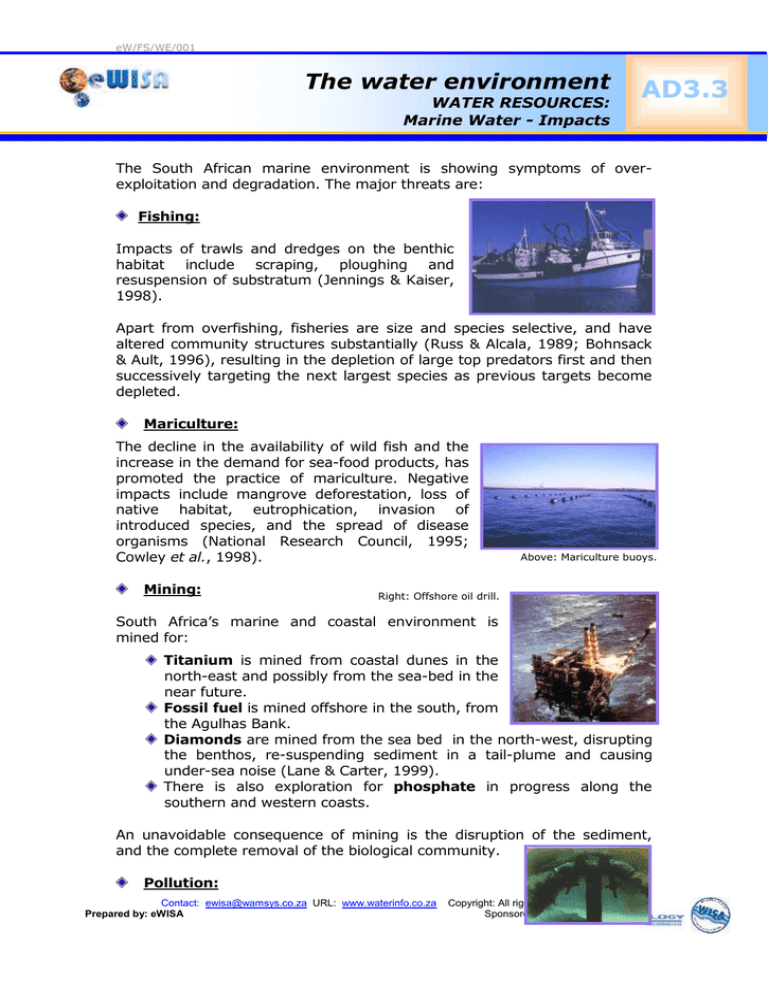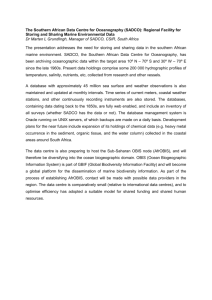
eW/FS/WE/001
The water environment
WATER RESOURCES:
Marine Water - Impacts
AD3.3
The South African marine environment is showing symptoms of overexploitation and degradation. The major threats are:
Fishing:
Impacts of trawls and dredges on the benthic
habitat include scraping, ploughing and
resuspension of substratum (Jennings & Kaiser,
1998).
Apart from overfishing, fisheries are size and species selective, and have
altered community structures substantially (Russ & Alcala, 1989; Bohnsack
& Ault, 1996), resulting in the depletion of large top predators first and then
successively targeting the next largest species as previous targets become
depleted.
Mariculture:
The decline in the availability of wild fish and the
increase in the demand for sea-food products, has
promoted the practice of mariculture. Negative
impacts include mangrove deforestation, loss of
native habitat, eutrophication, invasion of
introduced species, and the spread of disease
organisms (National Research Council, 1995;
Cowley et al., 1998).
Mining:
Above: Mariculture buoys.
Right: Offshore oil drill.
South Africa’s marine and coastal environment is
mined for:
Titanium is mined from coastal dunes in the
north-east and possibly from the sea-bed in the
near future.
Fossil fuel is mined offshore in the south, from
the Agulhas Bank.
Diamonds are mined from the sea bed in the north-west, disrupting
the benthos, re-suspending sediment in a tail-plume and causing
under-sea noise (Lane & Carter, 1999).
There is also exploration for phosphate in progress along the
southern and western coasts.
An unavoidable consequence of mining is the disruption of the sediment,
and the complete removal of the biological community.
Pollution:
Contact: ewisa@wamsys.co.za URL: www.waterinfo.co.za
Prepared by: eWISA
Copyright: All right reserved
Sponsored by:
Pollution originates from land-based sources
(industrial, municipal, agricultural and run-off),
shipping activity (accidental and deliberate
discharges,
garbage
and
dumping)
and
atmospheric gases (soluble gases). Pollutants can
take on many forms, and might affect marine
biodiversity in several ways:
Offshore wastewater outlet.
Municipal Waste site.
Toxicity.
Industrial wastes, such as heavy metals, petroleum products,
halogenated hydrocarbons and radioactive waste can lead to an
increase in infections, tumours and diseases in marine fish (Vethaak &
Rheinaldt, 1992). Heavy metals accumulate in food chains, poison top
predators and render seafood unsafe for human consumption.
Eutrophication.
Effluent from sewage systems or food processing, leads to excessive
organic loading, which causes eutrophication and anoxia. Increased
nutrient levels promote primary production, but often lead to a
reduction in local diversity and an increased frequency, duration and
intensity of noxious red tides (National Research Council, 1995).
Sediment loading.
Increased erosion of soil can lead to
increased levels of particulate matter in
the water, which increases turbidity,
reduces plant growth and clogs the
filtering appendages of many organisms
low down in the food chain.
Erosion and sediments entering the sea
through river mouth.
Plastic pollution.
In South Africa, plastics contribute about 90% of marine litter (Ryan,
1990). Marine organisms may ingest or become entangled in plastic
waste.
Oil pollution.
Marine crude oil physically
smothers intertidal organisms
and fouls feathers and fur.
The survival of the endemic
African penguin Spheniscus
demersus is threatened by oil
spills (Crawford, 1998).
Below: Oil polluted
penguins, in the process
of being cleaned.
Above: The endemic
African penguin
Spheniscus demersus
Aesthetic pollution.
Effluents may discolour coastal water and impact on recreational usage.
Garbage and plastics are also unsightly.
Contact: ewisa@wamsys.co.za URL: www.waterinfo.co.za
Prepared by: eWISA
Copyright: All right reserved
Sponsored by:
Invasion of alien species:
South Africa has fortunately very few alien species in our marine
environment, however, there is the European mussel Mytilus
galloprovincialis that has invaded the west coast (Grant & Cherry, 1996),
where it has restructured intertidal communities. The invasion of the
European shore crab Carcinus meanis has the potential to devastate
populations of molluscs (Le Roux et al., 1990).
Climate change:
Pollution of the atmosphere is resulting in increased levels of UV radiation
and a reduction in back-radiation from the earth. The former directly
damages tissues of plants and animals. The latter is leading to a change in
the heat balance of the globe, causing shifts in weather patterns and
temperature regimes.
Artificial reefs:
Artificial reefs have been created legally and illegally in South Africa. The
structures themselves may present a pollution threat.
Human pressure on the coastal zone:
The underlying cause of most problems related to
biodiversity is human population growth and the
attendant
pressure
on
natural
resources.
Increased pedestrian and vehicle traffic on the
shore is causing damage to dune plants and
threatening the breeding success of coastal birds,
like the African Black Oystercatcher Haematopus
moquini (Hockey, 1997).
African Black Oystercatcher
Haematopus moquini
The major cause of estuarine degradation is through land-use changes and
the anthropogenic manipulation of riverine flow, but residential, industrial
and agricultural pollution is rapidly becoming a major problem (Whitfield,
1997).
Scientific and commercial specimen collecting and bioprospecting:
A potential threat to rare species is caused by collections for scientific
investigations and the aquarium trade. The rarer the organism, the more
valuable it is and hence its vulnerability increases.
Organisms are screened for compounds that may be of use in medicine (e.g.
the cure for cancer), traditional healing (e.g. fertility enhancers) and
industrial applications (e.g. bio-adhesives). The marine bio-prospecting
industry is poorly regulated in South Africa.
(http://www.nrf.ac.za/publications/marinerep/conserve.htm)
Contact: ewisa@wamsys.co.za URL: www.waterinfo.co.za
Prepared by: eWISA
Copyright: All right reserved
Sponsored by:





